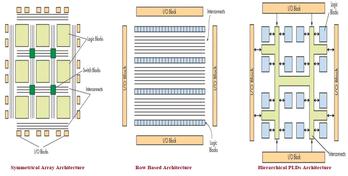FPGA Advantages and Disadvantages: A Comprehensive Overview
Advertisement
This page covers the advantages and disadvantages of FPGAs (Field Programmable Gate Arrays). It details the benefits and drawbacks associated with using FPGAs.
Introduction: What is an FPGA?
An FPGA is a semiconductor integrated circuit (IC) that can be programmed after it has been manufactured. This makes it incredibly flexible.
The core of an FPGA consists of a matrix of Configurable Logic Blocks (CLBs), which are interconnected according to the loaded program. Hardware Description Languages (HDLs) like VHDL and Verilog are typically used to write the code for FPGA programming.
Flashing the code onto an FPGA is straightforward, similar to programming a PROM (Programmable Read-Only Memory).

Figure 1: FPGA Architecture
As shown in Figure 1, an FPGA IC contains a collection of cells (e.g., LUTs - Look-Up Tables). These logic cells are surrounded by an interconnect fabric. Both the LUTs and the fabric can be programmed. FPGAs are often used for low-speed, low-volume, and less complex operations.
Benefits or Advantages of FPGA
Here are the key benefits of using FPGAs:
- Parallel Processing: FPGAs can be programmed at the logic level, enabling faster and parallel processing of signals. This kind of parallel execution is often difficult to achieve efficiently with traditional processors.
- Reprogrammability: Unlike ASICs (Application-Specific Integrated Circuits), which are fixed once programmed, FPGAs are programmable at the software level and can be reprogrammed any number of times. This also means that FPGAs can be programmed remotely.
- Faster Time-to-Market: FPGA ICs are readily available and can be programmed using HDL code relatively quickly. This allows for a faster time-to-market compared to solutions requiring custom ASICs.
- Lower Development Costs: ASIC development involves significant NRE (Non-Recurring Expenses) and requires costly tools. FPGA development is generally cheaper due to less expensive tools and the absence of NRE.
- Simplified Design Flow: In FPGA design, software handles routing, placement, and timing. This reduces the amount of manual intervention needed. The design flow eliminates the complex and time-consuming processes of place and route, floor planning, and timing analysis typically associated with ASICs.
Drawbacks or Disadvantages of FPGA
Despite their advantages, FPGAs also have some drawbacks:
- Programming Complexity: Programming FPGAs requires knowledge of VHDL/Verilog programming languages, as well as a solid understanding of digital system fundamentals. The programming process isn’t as simple as using a language like C with processor-based hardware. Engineers also need to learn how to use simulation tools.
- Higher Power Consumption: FPGAs generally consume more power than ASICs. Programmers often have limited control over power optimization within the FPGA itself.
- Resource Constraints: Once a particular FPGA is selected, programmers are limited to the resources available on that specific IC. This can constrain design size and features. Selecting the appropriate FPGA at the beginning of a project is crucial.
- Cost for High-Volume Production: FPGAs are well-suited for prototyping and low-quantity production runs. However, as the manufacturing quantity increases, the cost per unit also increases. This is not typically the case with ASIC implementations, where the cost per unit decreases significantly at higher volumes.
Advertisement
 RF
RF




